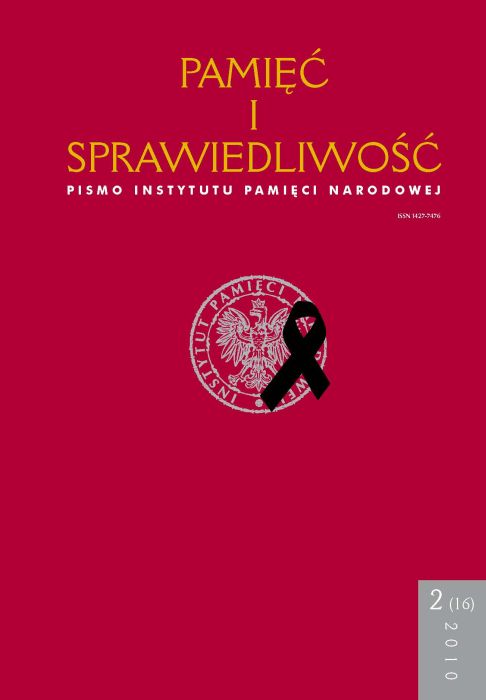Zarys historii sowieckiego obozu specjalnego nr 4 (Stiepłagu) w latach 1948–1954
Pamięć i Sprawiedliwość, V. 16 N. 2 (2010), pages: 273-293
Publication date: 2010-12-30
Abstract
The MVD-USSR special camp no. 4 (the Stiepnyj) was located in territory of the Kazak Soviet Socialist Republic. Under the guise of arresting “extremely dangerous criminals”, Soviet secret service (the NKVD) detained many political prisoners. The Stiepnyj camp was a complex of, initially eight, then nine smaller camps (sub camps) for 25 000 inmates. On 1 September 1949, the total
number of “extremely dangerous criminals” was 23 223. In the end of December 1952, detained Ukrainians were in the majority, then Lithuanians, Russians and Latvians. Another group of detainees was mainly comprised of members of the Polish resistance movement – the Home Army (sentenced between 1944–1945 to imprisonment) and of soldiers of the self-defence groups in South-eastern Kresy Region fighting against Soviet dictatorship, after 1945. The political prisoners of the Stiepnyj’s camp were subjected to a rough regime. Every inmate was given the prisoner’s camp number which was to be visible on their uniforms. All buildings considered habitable – such as barracks and dugouts, had bars on windows and each night were closed. Moreover, the inmates were forced to work in mines of black and brown coal, iron, copper and manganese ores, in copper factories, quarries and to assist in building new dwellings. They were also exploited as farmers and brick factory workers. It was popularly believed that, mines’ and quarries’ works were extremely tough, and dangerous because of unsafe and unhealthy working conditions (heavy dust concentration) and of frequently occurring industrial accidents leading up to many serious injuries or to a physical handicap. What is more, none of the basic recruitments relating to occupational health and safety standards were not met. Many deaths at work were related to several diseases workers suffered from, like: disability, dystrophy, pneumonia, circulatory system malfunction. In addition to this, the barracks were overcrowded which meant 1,15 square meters per person of the square footage in sub camp no. 1 and 2,74 square meters per person in sub camp no. 8. The “Kengir uprising” began in Stiepnyj camp on 17 may 1954, which was one of the biggest rebellions in the Soviet camp system. During the night of 26 June 1954, with 1600 soldiers sent to quell it, 37 persons were killed and several dozen were wounded. The break out of the “Kengir uprising”, and solidarity of the prisoners in their fight for release, all those accorded to the Stiepnyj camp a special position in the history of the Soviet camp system.
Puoi leggere altri articoli dello stesso autore/i
- Dariusz Rogut, „Więzień skryty i obcy obecnemu ustrojowi” - komunistyczny aparat bezpieczeństwa wobec pułkownika Franciszka Studzińskiego „Rawicza”, „Kotliny ” (1893-1964) , Pamięć i Sprawiedliwość: V. 38 N. 2 (2021)
- Dariusz Rogut, Nieznana historia. Obóz NKWD nr 515 w Północnoosetyjskiej Autonomicznej Socjalistycznej Republice Sowieckiej dla internowanych obywateli polskich (kwiecień–wrzesień 1945 roku) , Pamięć i Sprawiedliwość: V. 40 N. 2 (2022)
 Język Polski
Język Polski
 English
English
 Deutsch
Deutsch
 Français (France)
Français (France)
 Italiano
Italiano
 Русский
Русский


 PDF (Język Polski)
PDF (Język Polski)
